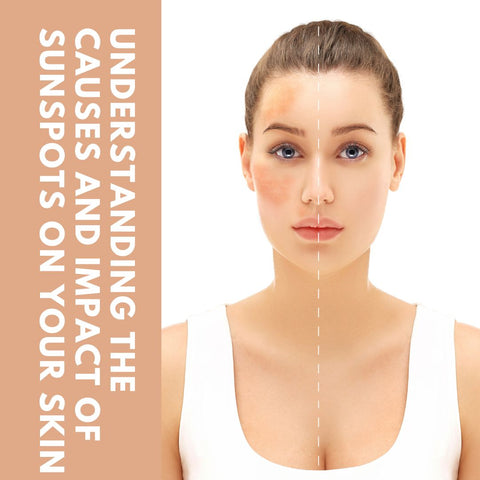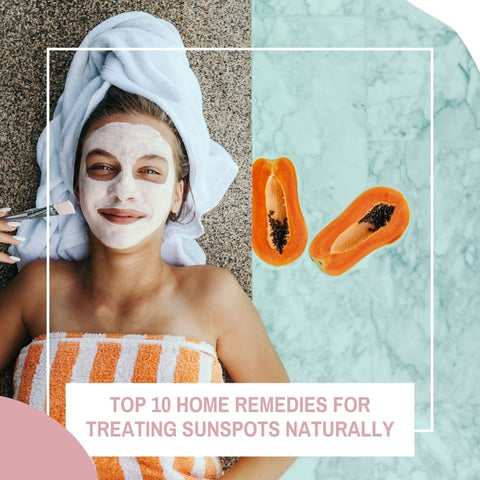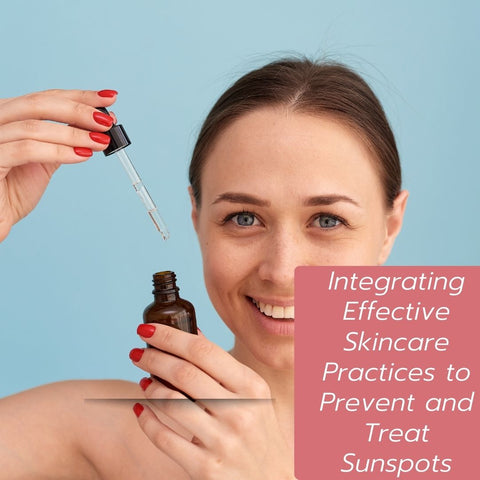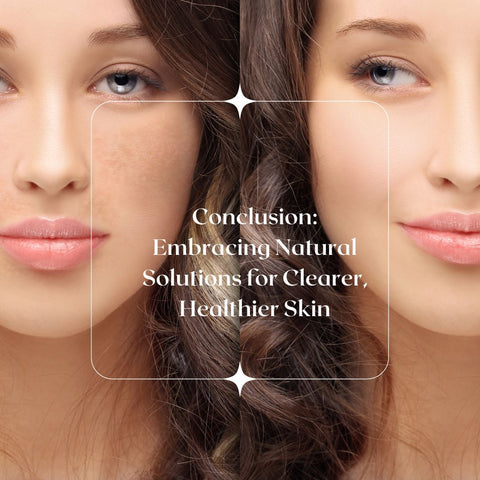Sunspots, also known as solar lentigines or age spots, are pigmented skin spots caused by prolonged exposure to the sun's ultraviolet (UV) rays. While they are typically harmless, many people seek natural remedies to reduce the appearance of sunspots. In this blog, we will look at some effective home remedies and treatments for sunspots.
Understanding the Causes and Impact of Sunspots on Your Skin

Sunspots are pigmented spots that develop on the skin as a result of continuous exposure to ultraviolet (UV) radiation from the sun. They are sometimes referred to as solar lentigines or age patches. Understanding the causes and effects of sunspots can help you choose the best treatments and take preventive measures.
Exploring the Science Behind Sunspots and Hyperpigmentation
Melanin, the pigment that gives skin its colour, is overproduced in sunspots and hyperpigmentation, two common skin conditions. Gaining knowledge of the science underlying these occurrences can help identify their origins and contribute to the creation of efficient remedies. An examination of the science underlying sunspots and hyperpigmentation is provided below:
-
Melanin and Pigmentation: Melanocytes are specialised cells found in the epidermis's basal layer that produce melanin. The tyrosinase enzyme aids in the enzymatic conversion of tyrosine into melanin.
-
UV Radiation and Melanin Production: Exposure to ultraviolet (UV) radiation, specifically UVA and UVB rays, stimulates the production of melanin by melanocytes. To protect skin cells from UV-induced DNA damage, the skin produces more melanin.
-
Formation of Sunspots: Extended exposure to UV rays can cause melanin to accumulate in some parts of the skin. The formation of dark spots, also referred to as sunspots or age spots, is the outcome of this clumping.
-
Inflammation and hyperpigmentation: The term "post-inflammatory hyperpigmentation" (PIH) refers to the overproduction of melanin that results from inflammatory conditions like acne or skin injuries. Melanocytes may produce excess melanin during the healing process, resulting in hyperpigmentation.
-
Hormonal Influences: Hormonal changes, such as those experienced during pregnancy or while taking birth control pills, can cause melasma, a type of hyperpigmentation. Hormonal fluctuations can cause melanocytes to produce more melanin, resulting in darkened patches of skin.
-
Genetic Factors: Genetic factors influence a person's predisposition to pigmentation issues. People with Fitzpatrick skin types III to VI are more likely to have hyperpigmentation. Genetic variations can influence how the skin responds to UV exposure, as well as how melanocytes produce and distribute melanin.
-
Treatment Approaches: Hydroquinone, retinoids, alpha hydroxy acids (AHAs), and vitamin C are common ingredients used to treat hyperpigmentation. Chemical peels can help fade dark spots by exfoliating the outer layers of skin. Some laser treatments target melanin in the skin, breaking down pigmented areas.
-
Preventive Measures: Sunscreen with broad-spectrum protection is essential for preventing sunspots and hyperpigmentation. Limiting sun exposure, particularly during peak hours, helps to reduce UV-caused skin damage. Wearing hats, sunglasses, and protective clothing provides an additional layer of protection against UV rays.
The Role of UV Radiation in Sun Damage and Skin Discoloration
UV (ultraviolet) radiation is primarily responsible for sun damage and skin discoloration, including sunspot formation and hyperpigmentation. UVA, UVB, and UVC photons make up solar radiation, although only UVA and UVB rays can reach Earth's surface. It is essential to comprehend how UV radiation causes sun damage and skin pigmentation to put effective sun protection techniques into practice. This is a synopsis:
-
UVA and UVB Rays: UVA rays penetrate the skin more deeply and are linked to premature ageing. They contribute to the breakdown of collagen and elastin fibres, which causes wrinkles and loss of skin elasticity. UVB rays primarily affect the skin's outer layer, causing sunburn. They play an important role in the development of sunspots, hyperpigmentation, and skin cancer.
-
Melanin and Pigmentation: Melanocytes produce melanin as a defence mechanism when the skin is exposed to UV radiation. Melanin helps shield the skin from UV rays by absorbing and dispersing them, but prolonged exposure can cause an imbalance in the distribution of melanin, which can cause sunspot formation as well as tanning.
-
Sunspots and Hyperpigmentation: Prolonged exposure to UV light can cause melanin in some skin areas to clump together over time. These clumps cause darkened areas on the skin to develop into sunspots, also known as age spots. UV exposure can activate melanocytes, which leads to an excess of melanin production and the appearance of hyperpigmentation.
-
DNA Damage and Inflammation: UV radiation has the potential to directly damage skin cells' DNA, resulting in mutations that may exacerbate skin cancer. UV-induced skin inflammation can lead to a rise in the synthesis of melanin, which exacerbates hyperpigmentation.
-
Role in Melasma: Solar radiation can exacerbate melasma, a type of hyperpigmentation associated with changes in hormones. UV exposure and hormonal changes can cause melanocytes to produce more melanin than necessary, which can result in the formation of dark patches.
-
Photodamage and Collagen Breakdown: UV radiation plays a role in the degradation of collagen and elastin fibres in the skin. UV exposure causes significant photodamage, which contributes to the development of wrinkles, fine lines, and other premature ageing signs.
-
Preventive Measures: A broad-spectrum sunscreen with SPF 30 or higher protects the skin from both UVA and UVB rays. Limiting sun exposure, particularly during peak hours, lowers the risk of UV-related skin damage. Hats, sunglasses, and clothing that cover exposed skin offer additional protection.
-
Post-Sun Exposure Care: Using products with soothing and hydrating ingredients can help alleviate skin discomfort after sun exposure. Topical treatments containing vitamin C, retinoids, and alpha hydroxy acids may help to address sun damage and promote skin renewal.
Top 10 Home Remedies for Treating Sunspots Naturally

If you are looking for natural ways to treat sunspots at home, here are the top ten remedies that may help reduce the appearance of sunspots.
-
Lemon Juice: Apply fresh lemon juice directly to sunspots with a cotton ball. Rinse it off after 15-20 minutes of application. Lemon juice contains citric acid, which acts as a natural bleach and may help lighten dark spots gradually.
-
Apple Cider Vinegar: Mix equal parts apple cider vinegar and water. Apply the solution to the sunspots with a cotton ball. Rinse after 20-30 minutes of application. Acetic acid in apple cider vinegar can exfoliate the skin and lighten dark spots.
-
Aloe Vera Gel: Apply fresh aloe vera gel directly to the sunspots. Allow it to sit for 30 minutes before rinsing. Aloe vera has anti-inflammatory and healing properties that may aid in skin regeneration.
-
Onion Juice: Extract the onion juice and apply it to the sunspots. Before rinsing, leave it on for 15 to 20 minutes. Quercetin is one of the compounds found in onions that may lighten skin.
-
Castor Oil: Apply castor oil to the sunspots and gently massage them in. After an overnight application, rinse the next morning. The antioxidants and fatty acids in castor oil may help promote skin regeneration and healing.
-
Papaya Mask: Mash some ripe papaya and use it to cover the sunspots. Before rinsing, leave it on for 20 to 30 minutes. Papain, one of the enzymes found in papaya, may aid in exfoliation and the fading of dark spots.
-
Green Tea Extract: Apply cotton balls dipped in cooled green tea extract to the sunspots. If you want to rinse it, leave it on for 15 to 20 minutes. Antioxidants like catechins, which are abundant in green tea, may have skin-brightening properties.
-
Turmeric Paste: Combine turmeric powder and water to make a paste. Spot the sunspots with the paste. Before rinsing, leave it on for 15 to 20 minutes. The compound curcumin, which has anti-inflammatory and skin-brightening effects, is found in turmeric.
-
Yoghurt Mask: Apply plain yoghurt to the sunspots. Before rinsing, leave it on for 20 to 30 minutes. The lactic acid in yoghurt may help with skin renewal and exfoliation.
-
Licorice Extract: Apply licorice extract to sunspots with a cotton ball. Wait 15-20 minutes before rinsing. Licorice extract contains compounds such as glabridin, which may have skin-lightening and anti-inflammatory properties.
While these home remedies may help reduce the appearance of sunspots, it is critical to seek personalised advice from a dermatologist, especially if you have concerns about your skin or if the sunspots persist.
Harnessing the Power of Lemon Juice and Aloe Vera for Skin Rejuvenation
Lemon juice and aloe vera are two natural ingredients that have been widely praised for their potential skin rejuvenation properties. Let us look at how lemon juice and aloe vera can help you achieve healthier, more rejuvenated skin:
-
Brightening and Exfoliation: Lemon juice contains citric acid, a natural exfoliator. It contributes to the removal of dead skin cells, resulting in a brighter complexion.
-
Lightening Dark Spots: Lemon juice's citric acid has natural bleaching properties that can lighten dark spots and hyperpigmentation.
-
Balancing Oil Production: Lemon juice's astringent properties can regulate oil production and benefit oily or acne-prone skin.
-
Antioxidant Protection: Lemon juice is rich in vitamin C, an antioxidant that helps protect the skin from free radical damage and supports collagen production.
How to Use Lemon Juice:
-
To reduce the acidity, mix fresh lemon juice with equal parts water.
-
Apply the mixture to your face with a cotton ball.
-
Rinse with water after leaving it on for 10-15 minutes.
-
Before applying lemon juice, do a patch test to ensure it does not irritate the skin.
Utilizing Apple Cider Vinegar and Vitamin E to Combat Dark Spots
Due to their ability to reduce dark spots and encourage the skin to have an even tone, vitamin E and apple cider vinegar (ACV) are two natural components that are frequently used in skincare products. Let's look at several ways to use these components to lighten dark areas:
Apple Cider Vinegar (ACV) for Dark Spots:
-
Exfoliation and pH Balance: ACV contains malic acid, a gentle exfoliant that helps remove dead skin cells and promotes skin renewal. ACV's acidic nature may balance the skin's pH, reducing the development of dark spots.
-
Skin Brightening: ACV may have natural skin-lightening properties, resulting in a more even skin tone.
-
Antibacterial Properties: Acne-prone skin can benefit from ACV's antibacterial properties.
How to Remove Dark Spots with Apple Cider Vinegar:
-
Dilution: To make a diluted solution, mix equal parts ACV and water.
- Application: Using a cotton ball, apply diluted ACV to dark spots.
- Rinse: After a few minutes, rinse with water.
-
Frequency: If your skin accepts it well, start once a day and progressively increase.
Vitamin E for Dark Spots:
-
Antioxidant Protection: Vitamin E acts as an antioxidant, neutralising free radicals that can cause skin ageing and dark spots.
-
Skin Repair and Healing: Vitamin E promotes cell regeneration and helps repair damaged skin, including dark spots.
-
Moisturising Properties: Vitamin E's moisturising properties can help keep the skin hydrated and moisturiser reduce the appearance of dark spots.
How to Use Vitamin E for Dark Spots:
-
Capsule Application: Pierce a vitamin E capsule and rub the oil directly onto dark spots. Gently massage the oil into your skin. Allow it to sit overnight or rinse after 20-30 minutes.
-
Vitamin E Oil Blend: Mix vitamin E oil with a carrier oil, such as jojoba or almond oil. Apply the mixture to dark spots and leave on for several hours or overnight.
Exploring the Benefits of Glycolic Acid and Cucumber Extract for Skin Renewal
Glycolic acid and cucumber extract are two skincare ingredients with potential benefits for skin renewal and overall skin health. Let us look at the individual benefits of glycolic acid and cucumber extract.
Glycolic Acid for Skin Renewal:
-
Alpha Hydroxy Acid (AHA): Glycolic acid is an AHA that effectively exfoliates the skin's outer layer, encouraging the removal of dead skin cells and the turnover of new, fresh skin.
-
Increased Collagen Production: Glycolic acid promotes collagen synthesis, which improves skin elasticity and firmness. This can lead to a more youthful appearance.
-
Even Skin Tone: Glycolic acid can help reduce the appearance of dark spots and hyperpigmentation by exfoliating the skin and encouraging more even pigmentation.
-
Smoothing Effect: Using glycolic acid regularly can help reduce the appearance of fine lines and wrinkles by promoting skin renewal and texture.
-
Enhanced Penetration: Glycolic acid improves the penetration of other skincare ingredients, making them more effective.
How to Use Glycolic Acid:
-
If you are new to glycolic acid, begin with lower concentrations and gradually increase.
-
Glycolic acid can be found in a variety of skincare products, such as cleansers, toners, and serums.
-
Sunscreen should always be used during the day when using glycolic acid-containing products to protect the skin from increased sensitivity to sunlight.
Cucumber Extract for Skin Renewal:
-
Hydration and Cooling: Cucumber extract contains a high water content that hydrates the skin. It also has a cooling effect, which makes it suitable for irritated or sensitive skin.
-
Antioxidant Properties: Cucumber contains high levels of vitamins A and C, as well as antioxidants. These help to protect the skin against oxidative stress and free radical damage.
-
Anti-Inflammatory Effects: Cucumber extract has anti-inflammatory properties that can help calm and soothe irritated skin while also reducing redness and inflammation.
-
Skin Brightening: Cucumber extract, though not as potent as other ingredients, may provide a subtle brightening effect.
-
Puffiness Reduction: Cucumber slices are often used to reduce puffiness around the eyes due to their water content and anti-inflammatory properties.
How to Use Cucumber Extract:
-
Make your masks by blending cucumbers and applying the paste to your face.
-
Look for skincare products with cucumber extract, such as moisturisers, masks, and toners.
Integrating Effective Skincare Practices to Prevent and Treat Sunspots

Sunscreen protection and focused skincare techniques are used to prevent and treat sunspots. This is a thorough tutorial on using skincare techniques that work well to prevent and treat sunspots:
-
Use a broad-spectrum sunscreen with an SPF of 30 or higher. Apply generously and reapply every two hours, especially when outside. Limit your sun exposure, especially during peak hours (10 a.m. to 4 p.m.). Seek shade and wear protective clothing, such as hats and sunglasses.
-
Include vitamin C serums in your routine. Vitamin C is an antioxidant that protects the skin from free radicals produced by sun exposure.
-
Use skincare products containing AHAs, such as glycolic acid, for gentle exfoliation. This helps to promote cell turnover and reduce the appearance of sunspots.
-
Include retinol or prescription retinoids in your nightly routine. These can help to improve skin texture, reduce dark spots, and boost collagen production.
-
Look for ingredients such as licorice extract, niacinamide (vitamin B3), and arbutin, which are known to have brightening properties.
-
Moisturisers can help keep your skin hydrated. Hydrated skin is less likely to show signs of sun damage.
-
Look for products that contain cucumber extract, which has calming and soothing properties that can help sun-exposed skin.
-
To treat sunspots, consult a dermatologist about chemical peels that contain ingredients such as glycolic acid. Laser therapy can help to rejuvenate the skin by targeting pigmented areas.
-
Use natural remedies such as fresh lemon juice or aloe vera gel to treat sunspots. These may have a mild skin-brightening effect.
-
Regular skin check-ups with a dermatologist are recommended for the early detection and management of any skin issues. Maintain a healthy lifestyle that includes a balanced diet, regular exercise, and adequate hydration to promote overall skin health.
-
Skincare takes time, and consistent use of products is crucial for seeing results. Stick to your routine and be patient.
-
If you have PIH from sun exposure or other causes, treat the inflammation to avoid dark spots.
-
Speak with skincare professionals or dermatologists for tailored advice based on your skin type, concerns, and goals.
-
To promote overall skin health, eat a well-balanced diet rich in antioxidants, vitamins, and minerals. Sustain hydration levels to preserve the resilience and elasticity of your skin.
-
If you have sensitive skin, try to avoid using harsh skincare products that could irritate your skin.
To prevent and treat sunspots, it is best to combine targeted treatments with protective measures. Keep in mind that skincare is a holistic approach.
Developing a Comprehensive Skincare Routine for Sunspot Prevention
Sunspot prevention requires a multifaceted skincare regimen that combines preventative measures, targeted treatments, and consistent application. This is a step-by-step tutorial to assist you in creating a successful skincare regimen:
Morning Routine:
-
Cleanser: The aim of this is to cleanse the skin and get it ready for the next products. Select a mild, nourishing cleanser that is appropriate for your skin type from the options below.
-
Vitamin C Serum: Protects the skin from free radicals and enhances its brightness. Use a stable form of vitamin C in the form of a vitamin C serum. On the face, apply a few drops.
-
Moisturiser: The function of the skin barrier is preserved and hydrated. Select a non-comedogenic, sheer moisturiser.
-
Sunscreen: A vital component of sun protection that keeps sunspots at bay. Make sure you apply a broad-spectrum sunscreen with at least SPF 30. Particularly if you are outside, reapply every two hours.
Evening Routine:
-
Cleanser: Eliminate makeup, sunscreen, and impurities from the day. Use a gentle cleanser suitable for your skin type.
-
Chemical Exfoliation (2-3 times a week): Promotes cell turnover to prevent sunspots. Use a product containing glycolic acid or another AHA. Begin with a low concentration and gradually increase.
-
Treatment Products (Optional): Address specific concerns, such as hyperpigmentation. Consider using products containing niacinamide, licorice extract, or alpha arbutin.
-
Moisturizer: Hydrate and retain moisture. Select a nighttime moisturiser that meets your skin's needs.
Weekly or Bi-Weekly Treatments:
-
Mask (Optional): Offers additional hydration and targeted treatment. Apply a mask with aloe vera or hyaluronic acid to soothe and hydrate the skin.
Important Considerations:
-
Patch tests should be performed before introducing new products to ensure that they are suitable for your skin.
-
If you have specific concerns or conditions, seek personalised advice from skincare professionals or dermatologists.
Understanding the Potential of Almond Oil and Retinol in Skin Repair
Almond oil and retinol are two skincare ingredients that have been linked to improved skin repair. Let us look at the individual properties of almond oil and retinol and how they help with skin repair.
Almond Oil for Skin Repair:
-
Vitamins and Minerals: Vitamins E and A, which are vital for healthy skin, are abundant in almond oil. Vitamin A promotes cell regeneration, whereas vitamin E is an antioxidant that helps shield the skin from oxidative damage.
-
Moisturising: Almond oil is an excellent emollient, which means it helps to seal in moisture and keep the skin hydrated. Skin repair requires properly hydrated skin.
-
Reducing Inflammation: Almond oil has anti-inflammatory ingredients that can protect the skin's natural healing process by calming and soothing irritated areas.
-
Improved Skin Tone: Almond oil can reduce dark spots and hyperpigmentation, leading to a more even complexion.
-
Supporting Collagen Production: The nutrients in almond oil may help to support the production of collagen, which would improve the firmness and elasticity of the skin.
Retinol for Skin Repair:
-
Encouraging Collagen Synthesis: Retinol, a vitamin A derivative, is known to promote the formation of collagen, which is necessary for preserving the structural integrity of the skin and diminishing the visibility of wrinkles and fine lines.
-
Increasing Cell Turnover: Retinol helps the skin's natural exfoliation process go more quickly, which encourages the shedding of old skin cells and the formation of new, healthier ones.
-
Reducing Hyperpigmentation: By preventing the synthesis of melanin and promoting a more uniform distribution of pigment, retinol can aid in the fading of dark spots and hyperpigmentation.
-
Retinol Regular Use: Retinol can help reduce fine lines and wrinkles and smooth out the texture of the skin.
-
Combating Free Radicals: Retinol acts as an antioxidant, protecting the skin from free radicals and environmental damage.
Exploring Advanced Treatments: Hyaluronic Acid and Professional Interventions
Professional interventions and hyaluronic acid are cutting-edge treatments that can target particular problems, provide hydration, and plump up the skin. Let us examine the advantages of professional interventions and hyaluronic acid:
Hyaluronic Acid:
-
Intense Hydration: Hyaluronic acid acts as a natural humectant, attracting and retaining moisture. It can hold up to 1000 times its weight in water, ensuring intense hydration for the skin.
-
Plumping Effect: Hyaluronic acid attracts water to the skin's surface, resulting in a plumping effect.
-
Supporting Collagen Production: Hyaluronic acid promotes collagen production, improving skin firmness and elasticity.
-
Enhancing Product Absorption: Hyaluronic acid improves the absorption of other skincare products, increasing their effectiveness.
-
Suitable for All Skin Types: Hyaluronic acid is lightweight and non-comedogenic, making it suitable for all skin types, including oily and acne-prone ones.
How to Use Hyaluronic Acid:
-
Serums and Moisturisers: Use hyaluronic acid serums or moisturisers on clean, damp skin. This enables the acid to attract and retain moisture more efficiently.
-
Layering: Hyaluronic acid can be combined with other skin care products. Apply it before thicker creams or oils.
Professional Interventions:
-
Chemical Peels: Chemical peels exfoliate the skin's outer layer, improving texture and reducing pigmentation. Benefits include the ability to treat fine lines, uneven skin tone, and sunspots.
-
Microdermabrasion: A mechanical exfoliation technique that removes dead skin cells, promoting skin renewal. Benefits include improved skin texture, reduced fine lines, and increased skincare effectiveness.
-
Dermal Fillers (Hyaluronic Acid Fillers): The purpose of injectable treatments is to add volume, smooth wrinkles, and restore facial contours. Benefits include reducing fine lines, wrinkles, and volume loss.
-
Laser Therapy: Targeted laser energy is used to treat skin concerns such as pigmentation, wrinkles, and scars. Benefits include improved skin texture, reduced sunspots, and increased collagen production.
-
Microneedling: Micro-injuries are created using tiny needles to promote collagen production and enhance skin texture. Benefits include reduced fine lines, wrinkles, and acne scars.
Combining Hyaluronic Acid with Professional Interventions:
-
Pre-treatment Hydration: Including hyaluronic acid in your routine prior to professional treatments can improve skin hydration and recovery.
-
Post-treatment Support: Hyaluronic acid can be used after professional treatments to help the skin recover and stay hydrated.
Important Considerations:
-
Before undergoing any professional interventions, speak with a skincare professional or dermatologist to determine the best treatments for your skin concerns.
-
Before using new skincare products, perform patch tests to ensure that they are compatible with your skin.
Conclusion: Embracing Natural Solutions for Clearer, Healthier Skin

Adopting natural remedies can be a comprehensive and successful strategy for getting healthier, brighter skin. Adding natural products to your skincare regimen helps to improve the health of your skin overall as well as address specific issues. You can attain healthier, clearer skin by embracing natural remedies and customising your skincare regimen to meet your specific requirements. Since every person's skin type is unique, it's critical to observe how your skin reacts and modify it as necessary. Cheers to embracing the beauty of natural skincare products for a complexion that is vibrant and healthy!
































